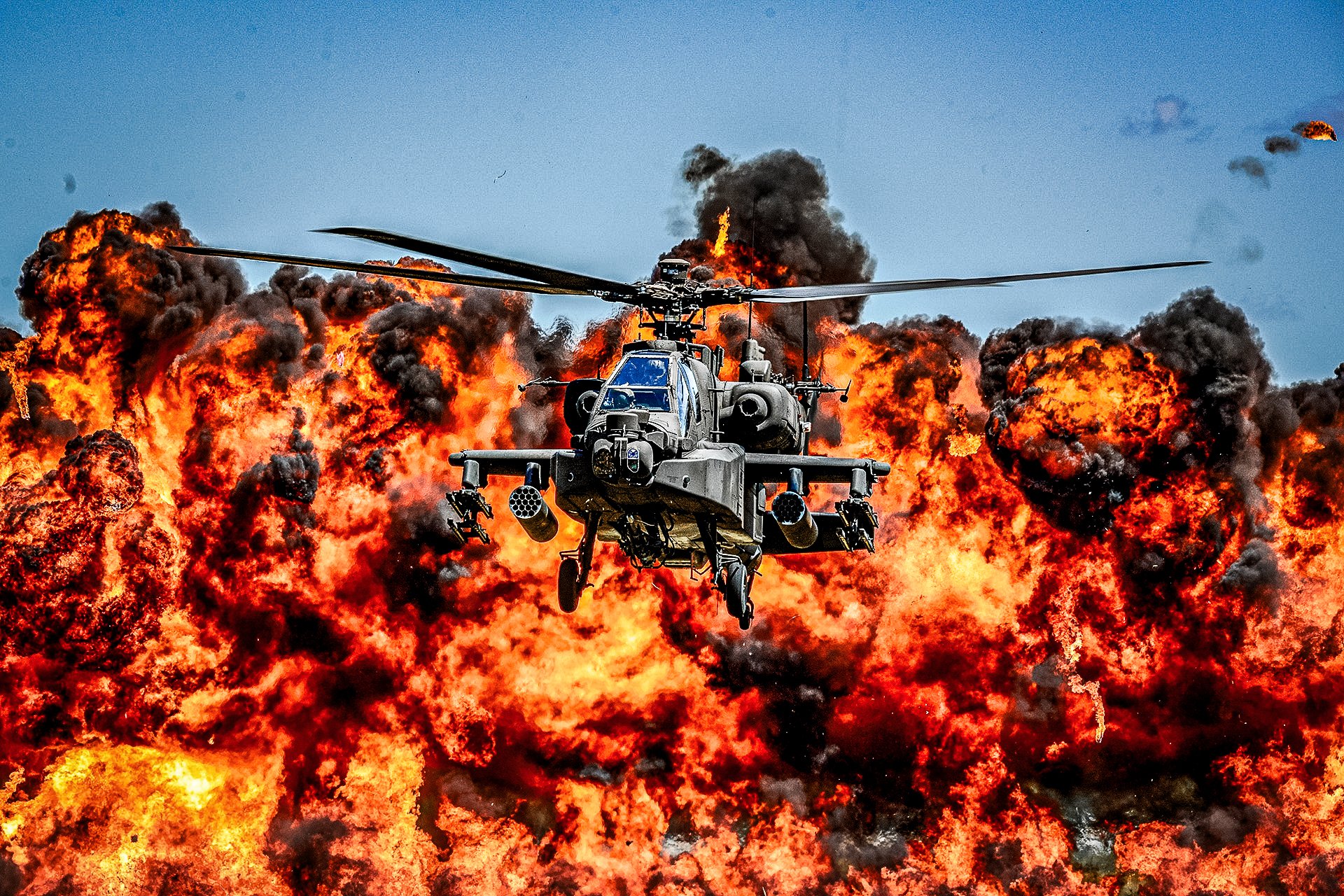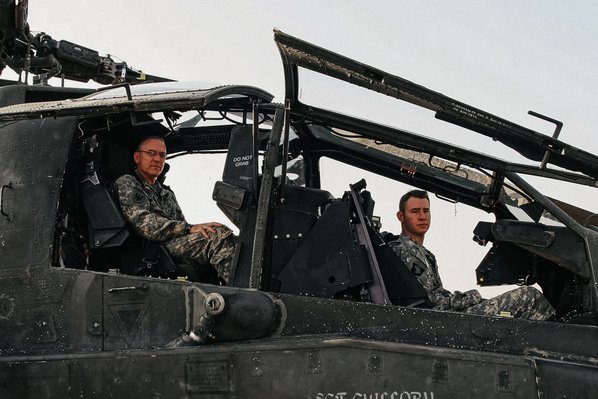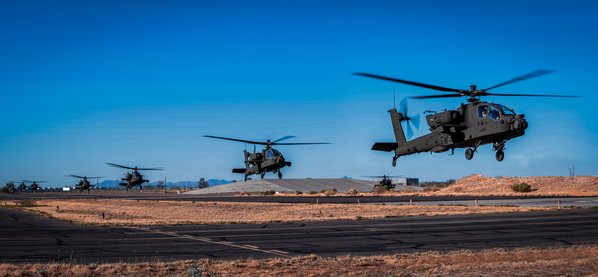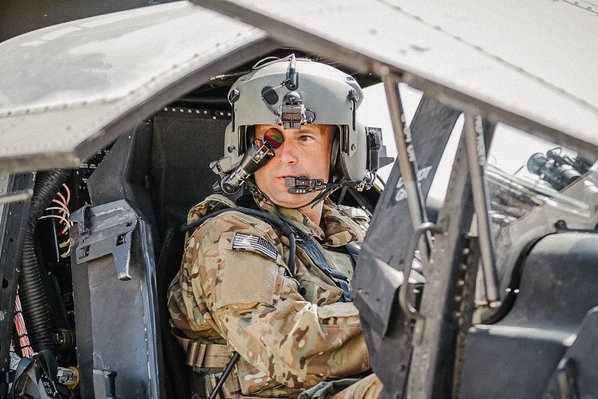
An AH-64D Apache attack helicopter flies in front of a wall of fire during the South Carolina National Guard Air and Ground Expo at McEntire Joint National Guard Base, S.C., May 6, 2017. Photo by Tech. Sgt. Jorge Intriago.
On the night of June 30, 2007, a platoon of US Army soldiers from the 77th Armor Regiment were ambushed by dozens of insurgents on the outskirts of Ramadi, Iraq. An intense firefight ensued, and soon there were casualties on both sides. When the Americans started to run low on ammunition, they called for reinforcements.
The quick reaction force arrived in a convoy of Humvees. Almost immediately, one of their turret gunners was critically wounded when an enemy round struck him in the face. Meanwhile, a formation of four AH-64A Apache attack helicopters from the 149th Aviation Regiment appeared in the sky overhead, unleashing a barrage of rockets to destroy a pair of tractor trailers the insurgents were using for cover.
Upon learning that the wounded turret gunner was on the verge of dying, one of the two-man Apache crews decided to attempt a brazen rescue. Pilot Chief Warrant Officer-4 Kevin Purtee descended through a flurry of gunfire and landed his helicopter. He remained in the cockpit while his co-pilot, Chief Warrant Officer-2 Allen Crist, dismounted to assist the infantrymen carrying the unconscious soldier.

Chief Warrant Officer-4 Kevin Purtee and Chief Warrant Officer-2 Allen Crist were each awarded the Distinguished Flying Cross for their actions in Iraq. US Army photo.
Because there are only two seats in an Apache, there wasn’t enough room for all three men inside the cockpit. So, after securing the wounded man into the co-pilot’s seat, Crist climbed onto the left wing of the helicopter, sat down, and secured himself to the bird with his safety restraint tether. Then he slapped the canopy glass, signaling to Purtee that he was ready, and they took off en route to a nearby refueling site, where an ambulance crew would be waiting to rush the gunner to a field hospital.
The pilots rearmed, refueled, and went back to helping the pinned-down infantrymen. Two Americans were ultimately killed in the firefight, which would later be remembered as the Battle of Donkey Island. However, despite the seriousness of his injuries, the gunner survived. For their role in ensuring he did, Purtee and Crist were both later awarded the Distinguished Flying Cross. They would also go down in history as the first Apache aircrew to ever perform a casualty evacuation of a non-aircrew member.
Related: What it Means to be an Apache Pilot, According to 6 Apache Pilots
Cold War and Beyond

US Army AH-64 Apache helicopter crews, assigned to 16th Combat Aviation Brigade, 7th Infantry Division, land at Wheeler Army Airfield, Hawaii, Jan. 6, 2016. US Army photo by Sgt. Daniel Johnson.
The battlefields of Vietnam provided an ample proving ground for US military aviation. In the early years of the war, helicopters such as the UH-1 Huey were utilized as transport platforms and to conduct medical evacuations. Then, as the war progressed and the fighting intensified, Hueys were modified with M60s, .50-caliber machine guns, and even rocket pods.
The Huey proved adequate as a gunship, but the US military still saw a need for an attack helicopter specially designed and equipped to support ground troops in combat. The most effective single-purpose attack helicopter to emerge during this period was the Bell AH-1 Cobra. Nicknamed “Snakes” for the way they zigzagged through the air, Cobras often served as security escorts for air transports and troop insertions. They also conducted hunter-killer missions to soften landing zones and reinforce ground units.
After the Vietnam War, the US military made it a priority to upgrade its fleet of attack helicopters amid escalating tensions with the Soviet Union. According to a CIA assessment about US intelligence and Soviet armor, the Warsaw Pact was on pace to produce an arsenal of artillery guns and advanced-armor tanks that would be four times the size of NATO’s by 1984. In the same report, the CIA also posited that NATO’s precision-guided missiles weren’t enough of a deterrent to counter the Soviet Union’s vision of using armor to control land and populations across Europe.

A US Army AH-64E Apache Guardian and an Indonesian Mi-35 Attack Helicopter take off for a flight together during an attack/reconnaissance training mission in Semarang, Indonesia, Sept. 9, 2014. US Army photo.
In the 1980s, the US Army contracted Hughes Helicopters (which was later acquired by McDonnell Douglas, which eventually became Boeing) to produce the AH-64A attack helicopter. Keeping with its tradition of naming helicopters after Native American tribes, the Army christened it Apache.
The AH-64A Apache first saw combat in Panama during Operation Just Cause. There, the Apache provided nighttime fire support for American ground troops. In the years that followed, the helicopters were used more and more frequently. During the First Gulf War, Apaches destroyed more than 500 Iraqi tanks, armored personnel carriers, and other enemy vehicles.

Since the 1980s, the UH-64 Apache helicopter has dominated the skies. Photo courtesy of Boeing.
Later, during the Global War on Terror, Apaches were used extensively in both Iraq and Afghanistan, often supporting infantry units and special operations forces conducting combat operations in both rural and urban environments. And on at least one occasion (see: the story recounted above), an Apache was used as a casualty-evacuation helicopter.
Having amassed 1.3 million flight hours in combat to date, the Apache can now be considered the most battle-proven attack helicopter in the world. Today, more than 15 countries — including Saudi Arabia, India, and the United Kingdom — use Apaches.
Related: An Apache Pilot Explains How To Go From Being an Enlisted Grunt to Flying Gunships
The World’s Most Advanced Helicopter Gunship

A US Army Apache pilot utilizing Integrated Helmet and Display Sighting System, or IHADSS. Photo courtesy of Elbit Systems.
Apaches are equipped with laser-guided precision Hellfire missiles, 70mm rockets, and a 30mm M230 Chain Gun. In the cockpit, advanced avionics and sighting systems allow the pilots to maneuver and track and engage targets in daytime and at night.
The Apache has an unconventional two-seat cockpit. Traditionally, two-seat aircraft have the pilot sitting in the front while the weapons system officer sits in the rear. In the Apache, however, the pilot is in the backseat, which is elevated above the front section to provide a better view of the battlespace. The gunner sits up front and controls the weapons and targeting sensor.
The Apache’s targeting sensor is called the Modernized Target Acquisition and Designation Sight, Pilot Night Vision System (M-TADS/PNVS). It is located on the nose of the aircraft and can rotate 120 degrees. The M-TADS/PNVS sensor essentially serves as a highly perceptive set of eyes, transmitting real-time imagery of the battlespace to the aviators in high-definition, night vision, or infrared.

Spc. Thomas Quinn, a Division Rapid Response Force Soldier for Battery C, 1st Battalion, 37th Field Artillery Regiment, 2nd Infantry Division, stands guard as an AH-64D Apache helicopter takes off after a downed aircraft training mission at Camp Taji, Iraq. US Army photo.
The imagery is displayed inside the specially designed helmets worn by the Apache’s crew. The Integrated Helmet and Display Sighting System, or IHADSS, tracks the head movements of the pilot and co-pilot, allowing them to track and fire upon targets without maneuvering the entire helicopter.
In 1997, the AH-64A was replaced by Boeing’s newer AH-64D Longbow. The most significant upgrade from the original model is the AH-64D’s Fire Control Radar. Located above the helicopter’s four-blade rotor, and capable of operating in all weather conditions, the FCR automatically searches for, locates, and prioritizes fixed and moving targets.
The latest version of the Apache is called the AH-64E Guardian. The new helicopters are equipped with much of the same technology as the earlier models, but are uniquely outfitted with the laser-based Common Infrared Countermeasures self-protection system, or CIRCM. The CIRCM is designed to deflect incoming heat-seeking, short-range surface-to-air missiles.
Read Next: The Flying Tank of the Soviet-Afghan War — A Brief History

Matt Fratus is a history staff writer for Coffee or Die. He prides himself on uncovering the most fascinating tales of history by sharing them through any means of engaging storytelling. He writes for his micro-blog @LateNightHistory on Instagram, where he shares the story behind the image. He is also the host of the Late Night History podcast. When not writing about history, Matt enjoys volunteering for One More Wave and rooting for Boston sports teams.
BRCC and Bad Moon Print Press team up for an exclusive, limited-edition T-shirt design!
BRCC partners with Team Room Design for an exclusive T-shirt release!
Thirty Seconds Out has partnered with BRCC for an exclusive shirt design invoking the God of Winter.
Lucas O'Hara of Grizzly Forge has teamed up with BRCC for a badass, exclusive Shirt Club T-shirt design featuring his most popular knife and tiomahawk.
Coffee or Die sits down with one of the graphic designers behind Black Rifle Coffee's signature look and vibe.
Biden will award the Medal of Honor to a Vietnam War Army helicopter pilot who risked his life to save a reconnaissance team from almost certain death.
Ever wonder how much Jack Mandaville would f*ck sh*t up if he went back in time? The American Revolution didn't even see him coming.
A nearly 200-year-old West Point time capsule that at first appeared to yield little more than dust contains hidden treasure, the US Military Academy said.












